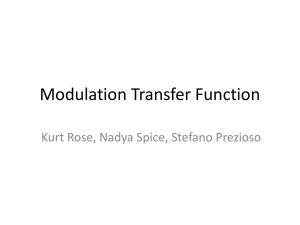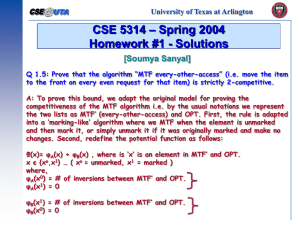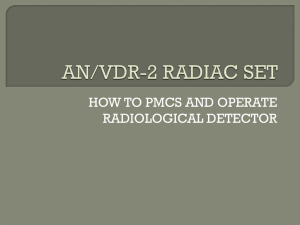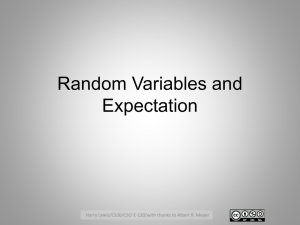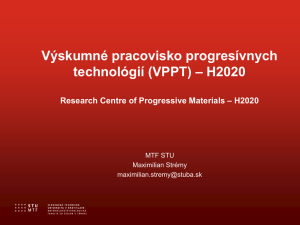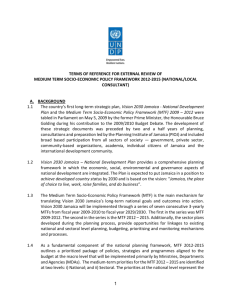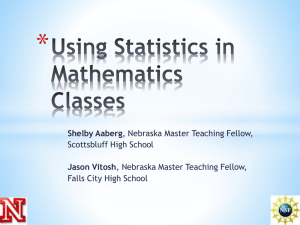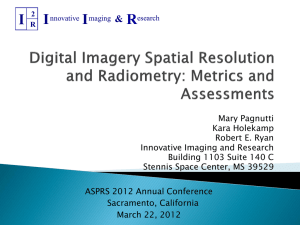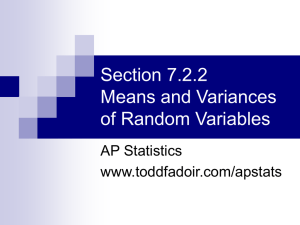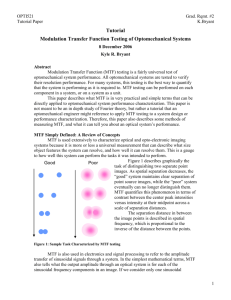MTF edge - hullrad Radiation Physics
advertisement
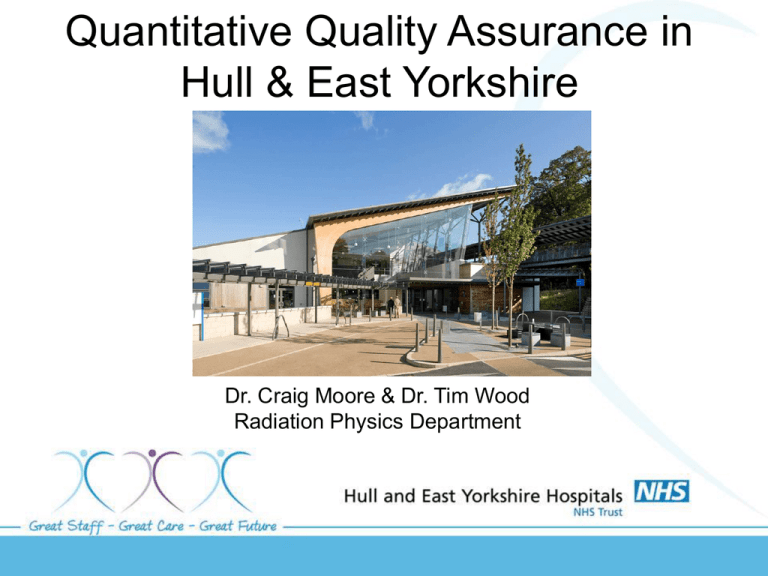
Quantitative Quality Assurance in Hull & East Yorkshire Dr. Craig Moore & Dr. Tim Wood Radiation Physics Department What imaging modalities do we have in Hull & East Yorks? • • • • • • Lots of Computed Radiography (CR) Some Direct Radiography (DR) CT MRI Full Field Digital Mammo (FFDM) Cone Beam CT – Dental – Radiotherapy imaging • Digital Fluoro labs • In this talk I’ll try to give you a flavour of the quantitative QA measurements we do on some of the above (with some results!!) What do we measure for CR and DR? • We (try to!!) conform to the requirements of IPEM Report 32 part 7 – – – – MTF NNPS SNR Variance as a function of dose Computed Radiography • Have been measuring MTF and NNPS of our CR systems for approx 5 years • Only have Agfa CR in Hull • Originally wrote own software in Matlab • But have since moved to IQWorks Measurement of CR MTF – – – – 1 uGy 4 uGy 12 uGy 50 uGy • Always with 1 mm Cu filtration and 70 kVp 3.50E+04 3.00E+04 mean PV • First need to derive the system transfer properties (STP) of the system, i.e. flat field images at doses of: 2.50E+04 y = 4265.1Ln(x) + 13221 2.00E+04 R = 0.9981 2 1.50E+04 1.00E+04 5.00E+03 0.00E+00 0.00 10.00 20.00 30.00 Dose (uGy) 40.00 50.00 60.00 Measurement of CR MTF • Acquire ‘MTF image’ using a tungsten metal edge tool, 50 x 50 mm and 1 mm thick 50mm 50mm Measurement of CR MTF tube 1.5m CR cassette MTF edge tool Typical results… Current 1 Baseline 0.9 0.8 0.7 MTF 0.6 0.5 0.4 0.3 0.2 0.1 0 0 0.5 1 1.5 2 2.5 3 Frequency (cycles m m -1) 3.5 4 4.5 5 Measurement of CR NNPS • Use the 4 uGy STP image • Use IQWorks (or Matlab) to do the number crunching Typical Results… Measurement of SNR and Variance • Use STP images – Linearise – Chop out central 5 cm square portion of image – Calc mean, standard deviation and variance – SNR = mean/SD – Plot STP corrected variance against dose STP Corrected Variance 6.00E-02 STP Corrected Variance 5.00E-02 y = 0.0019x 1.3266 R2 = 0.9924 4.00E-02 3.00E-02 2.00E-02 1.00E-02 0.00E+00 -1.00 1.00 3.00 5.00 7.00 9.00 11.00 13.00 Dose (uGy) Find relationship and quote the exponent If only quantum noise the exponent should be unity 15.00 CR results over time… • Over the last 5 years, we have seen no significant changes in – – – – – – MTF NNPS SNR Variance STP DDI calibration (Agfa’s ‘SAL log’ number) • Do these quantitative QA tests take any extra time? – No! – only one extra exposure required (MTF edge) as STP images would be taken anyway for detector response Getting the images off the system…… • For Agfa CR we set up a DICOM node on each system and send the image to our laptops – Must have DICOM server running on laptop – We use K-PACS – Images must always be acquired as: • System diagnosis • Flat field • Speed class 200 General DR measurements • We only have one general Philips DR system • Measure MTF, NNPS etc in the same manner as for CR • Grid removed MTF edge on detector housing Typical DR results… 1.2 7.00E-05 • STP is logarithmic (usually linear for a DR system) 1 6.00E-05 2500 0.8 5.00E-05 Current 4.00E-05 3.00E-05 0.4 2.00E-05 Mean Pixel Value 0.6 NNPS mm2 MTF 2000 Baseline NNPS current Typical CR NNPS Baseline 1500 Typical CR NNPS 1000 y = -320.39Ln(x) + 2286.7 R2 = 0.9999 0.2 500 1.00E-05 0 0 0.00E+00 0 0 1 0.00 0.5 10.00 1 2 3 20.00 30.00 1.5 2 lp/mm2.5 Spatial Frequency Dose (uGy) Spatial Frequency lp/mm 4 40.00 3 50.00 3.5 5 60.00 4 6 DR Variance • Variance as function of dose 0.2 0.18 1.2578 y = 0.0012x 2 R = 0.9967 STP Corrected Variance 0.16 0.14 0.12 0.1 0.08 0.06 0.04 0.02 0 0.00 10.00 20.00 30.00 Dose (uGy) 40.00 50.00 60.00 Hot off the press… 0 0.5 1 1.5 2 2.5 3 3.5 4 • Last week we found significant difference in MTF and NNPS from baseline of our DR system • Service engineer attending this Friday 1.00E-04 1.2 Measured Baseline 1 MTF(f) NNPS 0.8 0.6 1.00E-05 – Will be interesting to see if we find any 0.4 genuine issues!!! Measured X 0.2 Baseline X 0 0 1.00E-06 1 2 3 4 -1 SpatialSpatial frequency (lp (lp mm frequency mm -1) ) 5 6 7 DR image transfer • Not easy to transfer images – Same method as Agfa CR but Philips were very reluctant to help us with this FFDM Philips MicroDose • Photon counting full field digital mammo system • STP measured with 2 mm Al filter at the end of the collimator • MTF measured in a similar way to CR/DR • Edge tool placed on breast platform – No extra filtration – 32 kV/12 mAs – Approx 4cm from chest wall edge • Easy to take images off the system directly to an external hard drive Philips MicroDose MTF Modulation Transfer Function 1.2 1.0 MTF(f) 0.8 0.6 0.4 0.2 0.0 0 1 2 3 4 Spatial Frequency (lp per mm) 5 6 7 We did have an issue with one of our MicroDose systems!!! 1.0 MTF(f) 0.8 0.6 0.4 0.2 0.0 0 1 2 3 4 5 6 7 8 Spatial Frequency (lp per mm) Line Spread Function 1.2 1.0 0.8 Value • Strange shape to the MTF • Corresponding dip in LSF • No issues with basic TOR MAX line pair test • We went back to test the system but it passed Modulation Transfer Function 1.2 0.6 0.4 0.2 0.0 -0.2 -6 -4 -2 0 Distance (mm) 2 4 6 MicroDose Noise • We also measure detector response with dose • And quantum and structure variance 18000 Stucture variance Quantum variance AKref 16000 Baseline structure variance y = 24.93x - 245.87 2 R = 1.00 100 14000 Mean pixel value 80 % of total variance Baseline quantum variance 60 40 12000 10000 8000 6000 4000 20 2000 0 1 0 10 0 100 200 400 Detector dose (uGy) 600 Detector Air Kerma (uGy) 1000 800 Radiotherapy 2D on-board imaging • We work very closely with our RT colleagues wrt QA and testing of kV imaging systems kV tube – 2D and 3D • STP images – 1 mm Cu at tube port – 70 kVp – 1 to 20 uGy • MTF edge tool placed on imager – Approx 70 uGy • Same analysis and reporting as for diagnostic CR/DR • Get images off the system with the help of RT physicists imager RT 2D Imaging 0.0006 Modulation Transfer Function • Huttner image for this detector scored 12 groups (1.8 lp/mm) • This is much worse than this MTF suggests • Possible image processing on the acquisition monitor not applied to image sent for MTF analysis 1.2 0.0005 1.0 0.0004 NNPS MTF(f) 0.8 0.6 0.0003 0.4 0.0002 0.2 0.0001 0.0 6 5 4 3 2 1 – 0Does this demonstrate the usefulness of Spatial Frequency (lp per mm) doing quantitative QA? 7 0 0.0 0.5 1.0 1.5 Frequency lp/mm 2.0 2.5 RT 2D Imaging - Variance 1.40E-01 STP Corrected Variance 1.20E-01 1.00E-01 y = 0.0176x 2.0081 R2 = 1 8.00E-02 6.00E-02 4.00E-02 2.00E-02 0.00E+00 0.00 1.00 2.00 3.00 Dose (uGy) Genuine due to structure noise? 4.00 5.00 RT 3D Imaging • Use Catphan phantom • Measure the MTF with the bead tool • Measure CT numbers etc Measured Baseline 1 0.9 0.8 0.7 MTF 0.6 0.5 0.4 0.3 0.2 0.1 0 0 0.2 0.4 0.6 0.8 1 Spatial frequency (lp / mm) 1.2 1.4 1.6 Cone Beam Dental Imaging • Tests conform to HPA-CRCE-010 – Guidance on safe use of dental cone beam CT equipment • We use a specially designed phantom shaped like a jaw to hold Sedentex inserts CBCT Dental MTF Modulation Transfer Function 1.2 1.0 MTF(f) 0.8 0.6 0.4 0.2 0.0 0 1 2 3 4 Spatial Frequency (lp per mm) 5 6 7 Dental CBCT MRI Quantitative QA • Use Leeds Test Object MagIQ phantom • Measure: SNR Linearity Uniformity MTF 256 x 256 vertical 384 x 384 horizontal 384 x 384 vertical 512 x 512 horizontal 512 x 512 vertical 1 0.8 MTF – – – – 256 x 256 horizontal 0.6 0.4 0.2 0 0 0.2 0.4 0.6 0.8 1 1.2 -1 Spatial frequency (mm ) 1.4 1.6 1.8 2 Future Work • Want to start quantitative QA on our digital fluoro labs – Just recently found out (we think!!) how to take images off our Siemens and Philips systems • Thorough CT analysis via automated Catphan measurements • Non-CBCT digital dental • Do we want to start measuring effective MTF, NNPS, DQE etc???? – Similar to clinical set up with an appropriate phantom so not detector centric – But would be much more time consuming Conclusions • We have implemented routine quantitative testing (e,g. MTF, NNPS, SNR, Variance) into our QA programme, specifically for the following modalities: – – – – – CR DR FFDM CBCT (RT and Dental) MRI • No significant time penalty in doing these quantitative tests if software is already set up • We haven’t seen any significant changes in results over the years – but is this to be expected??? – We rarely see gross changes in Leeds Test Objects either • Vital we get cooperation from manufacturers to ensure we can easily acquire images in correct format and easily get them off the system
